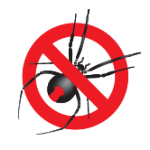
PEST CONTROL FOR SCHOOLS
One of the top priorities for schools on the Northside of Brisbane is providing a safe and healthy environment for students and staff. This includes effective pest control measures to prevent disease and structural damage from infestations.
Pest control is crucial for maintaining cleanliness and ensuring the safety of students and staff. Pests such as rats, mice, and cockroaches can spread pathogens that cause diseases, while termites can cause significant structural damage to school buildings. Furthermore, pests can create an uncomfortable and distracting environment, affecting the wellbeing and performance of students and staff.
The Department of Education in Queensland sets regulations for managing pests and maintaining a safe environment in schools. Integrated pest management plans must align with the Work Health and Safety Act 2011 and the Queensland School Environment Safety Guidelines.
The Benefits of Pest Control for Schools
As integral parts of communities, schools on the Northside of Brisbane face unique challenges in terms of maintaining safe and healthy environments. The subtropical climate can contribute to pest problems if left unchecked. Therefore, vigilant pest control measures are crucial. Let’s dive into the myriad benefits of pest control for schools.
A Clean and Sanitary Environment for Students and Staff
A tidy environment is both conducive to learning as well as the physical and psychological well-being of students and staff. Regular pest control for schools ensures a cleaner environment by keeping infestations at bay. Pests such as rodents and cockroaches can contaminate surfaces and transmit harmful bacteria. By addressing potential pest issues, schools are further safeguarding the health and welfare of their community.
Prevention of Diseases Spread by Pests
Various pests, especially rodents, cockroaches, and mosquitoes, can spread harmful germs and diseases. By investing in regular pest control, schools can significantly reduce the risk of infections amongst students and staff. This not only creates a healthier environment but can also result in fewer sick days and increased productivity throughout the school community.
Protection of School Buildings and Property from Structural Damage
Many pests can cause severe structural damage if left unchecked. For instance, termites are notorious for damaging wooden structures, while rodents have a reputation for gnawing through electrical wiring and other materials. Conducting regular pest control can identify infestations before they escalate into expensive repair or replacement costs. In turn, this maintains the school’s infrastructure and ensures its longevity for future generations.
Enhanced Learning Conditions and a Comfortable Atmosphere
It’s no secret that pests like flies, mosquitoes, and rodents can be distracting and make for an uncomfortable learning environment. By implementing effective pest control strategies, schools can eliminate these aforementioned irritants, thereby improving the overall atmosphere within the school. Consequently, students are better equipped to focus on their studies, resulting in a better learning experience for all.
Compliance with Health and Safety Regulations
Maintaining a pest-free environment in schools is not just a matter of comfort, but also a legal obligation. Schools must adhere to health and safety regulations set by the government; these regulations often include standards related to pest control. By engaging in consistent pest control practices, schools are not only creating a safe and welcoming space but also abiding by legal requirements, thereby preventing potential penalties.
What is the process of pest control for schools:
Pest control services for schools can include:

1. Inspection
Inspection and assessment of the school premises to identify problem areas and pests

2. Tailored Plan
Development of a tailored integrated pest management plan

3. Treatment
Treatment using environmentally friendly and safe methods

4. Monitoring
Regular monitoring and maintenance to keep the school pest-free

5. Support
Ongoing support, education, and guidance on how to prevent pest problems from recurring
What types of pests can be controlled in the schools

Rodents (rats and mice)
Not only are rodents a major nuisance, but they can also pose significant health risks. Rats and mice can spread various diseases, contaminate food, and cause structural damage to school buildings. Controlling rodents in schools involves implementing effective preventive measures such as sealing entry points, using secure bins and containers, and undertaking regular building maintenance.

Cockroaches
Cockroaches are prevalent in Queensland, and they are incredibly resilient creatures. Their presence in schools can lead to alarming health concerns, as they are known carriers of harmful bacteria and can be responsible for the spread of various diseases, including salmonella and gastroenteritis. Effective pest control measures, such as regular sanitation and maintenance, help in reducing the presence of these pesky critters.

Spiders
Schools on the Northside of Brisbane need to be vigilant about spider control, especially with the presence of venomous spiders such as the redback and funnel-web spiders. To minimise the risk of potential spider bites, it is essential to regularly inspect buildings and outdoor areas and remove any webs, nests or debris that may provide hiding spaces for these eight-legged pests.

Termites
Termites may not be as visible as rodents or cockroaches, but they can cause significant structural damage to school buildings if left unchecked. With Brisbane being a high-risk termite region, it is crucial to carry out regular termite inspections and treatments to protect both the structural integrity of school buildings and the safety of students and staff.

Ants
While ants are generally harmless, some species like fire ants and carpenter ants can be quite troublesome for schools. Fire ants can deliver painful bites that, in severe cases, can cause an allergic reaction. Carpenter ants, on the other hand, can burrow into wooden structures, causing damage to school property. Ensuring proper food storage and waste disposal can help reduce the incidence of ant infestations.

Wasps and bees
Wasps and bees can pose a serious threat to students and staff who might be allergic to their stings. Keeping playgrounds and outdoor areas safe and free from wasp nests and beehives is of paramount importance. Moreover, it is essential to enlist the help of professional pest control services to safely remove any nests or hives in school premises.
What is the cost of pest control for schools
The cost of pest control for schools depends on various factors such as the size of the school, the type and severity of the infestation, and the chosen treatment method. It’s best to contact Little Critters Pest Control & Termite Management Specialists for a free quote tailored to your school’s unique needs.
Why Choose Little Critters Pest Control Specialists for schools
Over 30 Years of Experience in Providing Effective and Safe Pest Control Solutions
With over three decades’ worth of experience, Little Critters Pest Control & Termite Management Specialists have the skills necessary to identify and treat a variety of pests found in schools, from common insects like ants and spiders, to rodents and termites. Our expertise in pest control allows us to effectively eliminate and prevent pest infestations while keeping the school environment safe for students and staff.
Knowledgeable and Friendly Team of Licensed Professionals
Our team at Little Critters Pest Control & Termite Management Specialists is not only experienced, but also friendly and approachable. We understand the importance of communication and collaboration with school staff, and we will work with you to develop the best possible pest control solution for your school. We are always happy to provide detailed explanations of our procedures and answer any questions you may have.
Tailored, Cost-effective Integrated Pest Management Plans
Every school is different, which is why we believe in creating customised, integrated pest management (IPM) plans that suit your school’s unique needs. By focusing on prevention, proper sanitation, regular maintenance, and targeted treatment methods, we can help keep your school pest-free in a way that is both effective and cost-efficient.
Safe and Environmentally Friendly Treatment Methods
At Little Critters Pest Control & Termite Management Specialists, we prioritise the well-being of students, staff and the environment. Our treatment methods are safe, environmentally friendly, and compliant with all relevant Australian Standards. We use state-of-the-art techniques and equipment to ensure that our pest control treatments pose minimal risk to people and the environment.
Adherence to Health and Safety Regulations
We understand that schools have strict health and safety regulations to adhere to, and we make it our mission to provide pest control services that are in complete compliance with those guidelines. Rest assured, our team is trained and knowledgeable about the latest health and safety protocols, and we will work with you to achieve a pest-free learning environment that aligns with these regulations.
Don’t let pests compromise the health and safety of your school. Contact Little Critters Pest Control & Termite Management Specialists today for a free, no-obligation quote to safeguard your school from pests. Call 1300 36 66 56, or send us an online enquiry using the form below.
Popular questions about pest control for schools
How often should schools have pest control services?
The frequency of pest control inspections depends on the size of the school, its location, and its history of pest issues. Generally, it is recommended that schools should schedule quarterly pest control inspections. However, if the school is located near wooded areas or has a history of frequent pest infestations, more frequent inspections may be necessary. Little Critters Pest Control & Termite Management Specialists will provide guidance on the optimal frequency of services based on assessment and ongoing monitoring.
What types of pests are commonly found in schools?
Some common pests found in schools include rodents (rats and mice), ants, cockroaches, silverfish, spiders, flies, and occasionally, termites or wasps. These pests can cause various issues, including contaminating food, damaging property, or potentially harming students and staff.
Are the pest control treatments safe for students and staff?
When performed by licensed professionals, pest control treatments are safe for children and adults in a school setting. Little Critters Pest Control & Termite Management Specialists prioritise the health and safety of students and staff. Environmentally friendly and safe methods are utilised to treat pests without posing a risk to people.
What are the best practices for preventing pest infestations in schools?
To prevent pest infestations in schools, the following strategies should be implemented:
– Proper sanitation and waste disposal to eliminate food sources for pests
– Regular building maintenance to ensure there are no cracks or gaps for pests to enter
– Sealing food storage areas and keeping food preparation areas clean
– Installing door sweeps and window screens to prevent pest entry
– Regular pest control inspections and timely treatment if pests are detected
– Educating staff and students about pest prevention measures
